Ozito OAST-050 Handleiding
Ozito
Niet gecategoriseerd
OAST-050
Bekijk gratis de handleiding van Ozito OAST-050 (8 pagina’s), behorend tot de categorie Niet gecategoriseerd. Deze gids werd als nuttig beoordeeld door 5 mensen en kreeg gemiddeld 4.3 sterren uit 3 reviews. Heb je een vraag over Ozito OAST-050 of wil je andere gebruikers van dit product iets vragen? Stel een vraag
Pagina 1/8

AUTO
SCANNER
OBD2/EOBD Code Reader
[ ] = SetuP
[ ] = Scan
OBDII
AUTO
SCANNER
OBD2/E OBD Co de Re ade r
[ ] = Se tuP
[ ] = Sca n
OBDII
AUTOMOTIVE
SCAN TOOL
OBD2 CODE READER
INSTRUCTION MANUAL
SPECIFICATIONS
Support: OBD2 Compliant Vehicles
Input: 8V to 25V
Operating Temp.: 0°C~50°C
Storage Temp.: –20° °C~70 C
Display: 128 x 64mm Backlit LCD
Weight: 0.15kg
OAST-050
STANDARD EQUIPMENT
3 YEAR REPLACEMENT WARRANTY*
Your product is guaranteed for a period of If 36 months from the original date of purchase.
a product is defective it will be replaced in accordance with the terms of this warranty. Warranty
excludes consumable parts, for example: .
*This product is intended for DIY use only and replacement warranty covers domestic use.
WARNING
The following actions will result in the warranty being void.
• If the tool has been operated on a supply voltage other than that specified on the tool.
• If the tool shows signs of damage or defects caused by or resulting from abuse, accidents
or alterations.
• Failure to perform maintenance as set out within the instruction manual.
• If the tool is disassembled or tampered with in any way.
• Professional, industrial or high frequency use.
WARRANTY
OZITO Australia/New Zealand (Head Office) 25 Fox Drive Dandenong South, Victoria, Australia 3175.
ozito.com.au
Automotive Scan Tool
0921
IN ORDER TO MAKE A CLAIM UNDER THIS WARRANTY
YOU MUST RETURN THE PRODUCT TO YOUR NEAREST
BUNNINGS WAREHOUSE WITH YOUR BUNNINGS
REGISTER RECEIPT. PRIOR TO RETURNING YOUR
PRODUCT FOR WARRANTY PLEASE TELEPHONE OUR
CUSTOMER SERVICE HELPLINE:
Australia: 1800 069 486
New Zealand: 0508 069 486
The benefits provided under this warranty are in addition to other rights and remedies which
are available to you at law.
Our goods come with guarantees that cannot be excluded at law. You are entitled to a
replacement or refund for a major failure and for compensation for any other reasonably
foreseeable loss or damage. You are also entitled to have the goods repaired or replaced if the
goods fail to be of acceptable quality and the failure does not amount to a major failure.
Generally you will be responsible for all costs associated with a claim under this warranty,
however, where you have suffered any additional direct loss as a result of a defective product
you may be able to claim such expenses by contacting our customer service helpline above.
TO ENSURE A SPEEDY RESPONSE PLEASE HAVE
THE MODEL NUMBER AND DATE OF PURCHASE
AVAILABLE. A CUSTOMER SERVICE REPRESENTATIVE
WILL TAKE YOUR CALL AND ANSWER ANY QUESTIONS
YOU MAY HAVE RELATING TO THE WARRANTY POLICY
OR PROCEDURE.

AUTO
SCANNER
OBD2/EOBD Code Reader
[ ] = SetuP
[ ] = Scan
OBDII
12V AUTOMOTIVE SCAN TOOL
KNOW YOUR PRODUCT
1. KNOW YOUR PRODUCT OVERVIEW
ONLINE MANUAL
Scan this QR Code with your mobile
device to take you to the online manual.
1. Backlit LCD
2. Red LED
3. Yellow LED
4. Green LED
5. Up Button
6. Back Button
7. OBD2, 16-Pin Connector
8. Down Button
9. OK Button
4
5
1
2
3
6
7 8 9
1. Backlit LCD
Indicates setup, scan, menu options and test results.
2. Red LED
Indicates there is a problem in one or more of the vehicle’s
systems. The red LED is also used to show that DTCs are present.
DTCs are shown on the Scan Tool’s display. In this case, the MIL
lamp on the vehicle’s instrument panel will light steady on.
3. Yellow LED
Indicates there is a possible problem. A “Pending” DTC is present
and/or some of the vehicle’s emission monitors have not run their
diagnostic testing.
4. Green LED
Indicates that engine systems are running normally (The number
of monitors on the vehicle which are active and performing their
diagnostic testing is in the allowed limit, and no DTCs are present).
5. Up Button
Scrolls up through menu items
6. Back Button
Returns to previous menu.
7. OBD2 16-Pin Connector
Connects the scan tool to the vehicle’s Data Link Connector (DLC).
Your DLC is usually located near centre under the instrument
panel (dash), under or around the driver’s side of most vehicles.
Do not force OBD2
Connector into the
DLC, ensure the
connector is in the
correct orientation
to the DLC to avoid
damaging the pins.
Note: Refer to your
vehicle’s service
manual for the
location if the DLC
cannot be found.
8. Down Button
Scrolls down through menu items.
9. OK Button
Confirms a selection (or action) from a menu item.
SETUP & PREPARATION

2. GENERAL INFORMATION
OBD2 Readiness Monitors
An important part of a vehicle’s OBD2 system is the Readiness
Monitors, which are indicators used to find out if all of the
emissions components have been evaluated by the OBD2
system. They are running periodic tests on specific systems and
components to ensure that they are performing within allowable
limits.
Currently, there are eleven OBD2 Readiness Monitors (or
I/M Monitors) defined by the U.S. Environmental Protection
Agency(EPA). Not all monitors are supported by all vehicles and
the exact number of monitors in any vehicle depends on the motor
vehicle manufacturer’s emissions control strategy.
• Some of the vehicle components or Continuous Monitors –
systems are continuously tested by the vehicle’s OBD2 system,
while others are tested only under specific vehicle operating
conditions. The continuously monitored components listed below
are always ready:
1. Misfire
2. Fuel System
3. Comprehensive Components (CCM)
Once the vehicle is running, the OBD2 system is continuously
checking the above components, monitoring key engine sensors,
watching for engine misfire, and monitoring fuel demands.
• Unlike the continuous monitors, Non-Continuous Monitors –
many emissions and engine system components require the
vehicle to be operated under specific conditions before the monitor
is ready. These monitors are termed non-continuous monitors and
are listed below:
1. EGR System 2. O2 Sensors
3. Catalyst 4. Evaporative System
5. O2 Sensor Heater 6. Secondary air
7. Heated Catalyst 8. A/C system
OBD2 Monitor Readiness Status
OBD2 systems must indicate whether or not the vehicle’s PCM’s
monitor system has completed testing on each component.
Components that have been tested will be reported as “Ready”, or
“Complete”, meaning they have been tested by the OBD2 system.
The purpose of recording readiness status is to allow inspectors
to determine if the vehicle’s OBDII system has tested all the
components and/or systems.
The powertrain control module (PCM) sets a monitor to “Ready” or
“Complete” after an appropriate drive cycle has been performed.
The drive cycle that enables a monitor and sets readiness codes to
“Ready” varies for each individual monitor. Once a monitor is set
as “Ready” or “Complete”, it will remain in this state. A number
of factors, including erasing of diagnostic trouble codes (DTCs)
with a scan tool or a disconnected battery, can result in Readiness
Monitors being set to “Not Ready”. Since the three continuous
monitors are constantly evaluating, they will be reported as
“Ready” all of the time. If testing of a particular supported non-
continuous monitor has not been completed, the monitor status
will be reported as “Not Complete” or “Not Ready”.
In order for the OBD monitor system to become ready, the vehicle
should be driven under normal operating conditions. These
operating conditions may include a mix of highway driving and
stop and go, city type driving, and at least one overnight-off period.
For specific information on getting your vehicle’s OBD monitor
system ready, please consult your vehicle owner’s manual.
OBD2 Definitions
• Powertrain Control Module (PCM) – OBD2 terminology for the
on-board computer that controls engine and drive train.
• Malfunction Indicator Light (MIL) – Malfunction Indicator Light
(Service Engine Soon, Check Engine) is a term used for the light
on the instrument panel. It is to alert the driver and/or the repair
technician that there is a problem with one or more of vehicle’s
systems and may cause emissions to exceed federal standards. If
the MIL illuminates with a steady light, it indicates that a problem
has been detected and the vehicle should be serviced as soon as
possible. Under certain conditions, the dashboard light will blink
or flash. This indicates a severe problem and flashing is intended
to discourage vehicle operation. The vehicle onboard diagnostic
system can not turn the MIL off until necessary repairs are
completed or the condition no longer exists.
• DTC – Diagnostic Trouble Codes (DTC) that identify which section
of the emission control system has malfunctioned.
• Enabling Criteria – Also termed Enabling Conditions. They are
the vehicle-specific events or conditions that must occur within the
engine before the various monitors will set, or run. Some monitors
require the vehicle to follow a prescribed “drive cycle” routine as
part of the enabling criteria. Drive cycles vary among vehicles and
for each monitor in any particular vehicle.
• OBD2 Drive Cycle – A specific mode of vehicle operation that
provides conditions required to set all the readiness monitors
applicable to the vehicle to the “ready” condition. The purpose
of completing an OBD2 drive cycle is to force the vehicle to run
its onboard diagnostics. Some form of a drive cycle needs to be
performed after DTCs have been erased from the PCM’s memory
or after the battery has been disconnected. Running through a
vehicle’s complete drive cycle will set the readiness monitors so
that future faults can be detected. Drive cycles vary depending
on the vehicle and the monitor that needs to be reset. For vehicle
specific drive cycle, consult the vehicle’s Owner’s Manual.
• Freeze Frame Data – When an emissions related fault occurs,
the OBD II system not only sets a code but also records a snapshot
of the vehicle operating parameters to help in identifying the
problem. This set of values is referred to as Freeze Frame Data and
may include important engine parameters such as engine RPM,
vehicle speed, air flow, engine load, fuel pressure, fuel trim value,
engine coolant temperature, ignition timing advance, or closed loop
status.
Product specificaties
| Merk: | Ozito |
| Categorie: | Niet gecategoriseerd |
| Model: | OAST-050 |
Heb je hulp nodig?
Als je hulp nodig hebt met Ozito OAST-050 stel dan hieronder een vraag en andere gebruikers zullen je antwoorden
Handleiding Niet gecategoriseerd Ozito
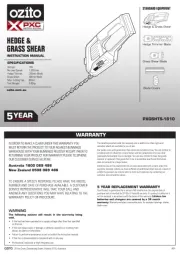
15 Augustus 2025
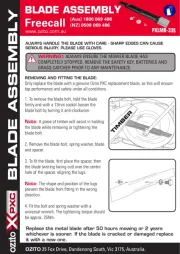
14 Augustus 2025
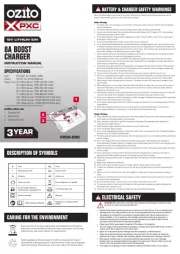
30 Juli 2025
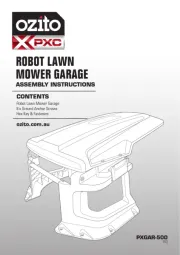
29 Juli 2025
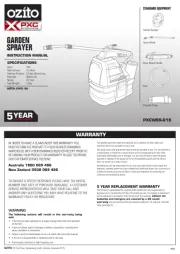
3 Juli 2025
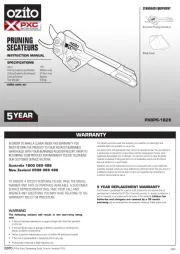
3 Juni 2025

10 December 2024

2 November 2024

8 April 2024

8 April 2024
Handleiding Niet gecategoriseerd
- SHX
- ReTrak
- Profoto
- HyperX
- Durvet
- Xunzel
- ZOTAC
- Yuede
- Uniross
- Viper
- Cricut
- Riccar
- Vacmaster
- Edge
- Luxor
Nieuwste handleidingen voor Niet gecategoriseerd

14 September 2025

14 September 2025

13 September 2025

13 September 2025

13 September 2025

13 September 2025

13 September 2025

13 September 2025

13 September 2025

13 September 2025